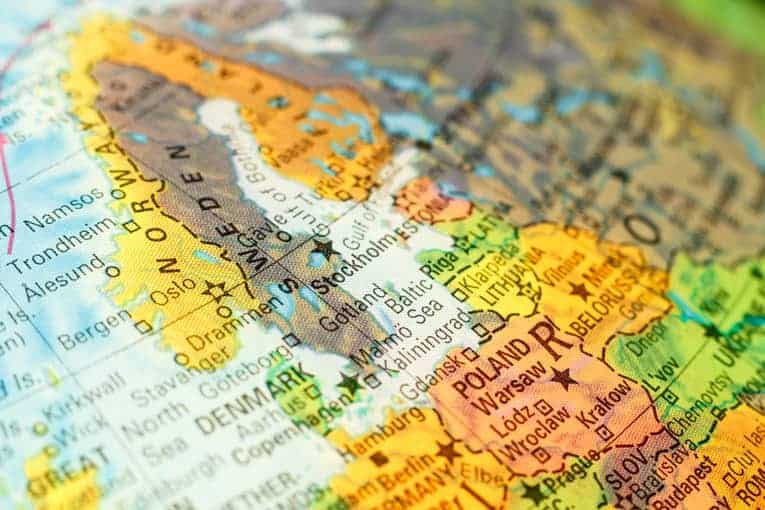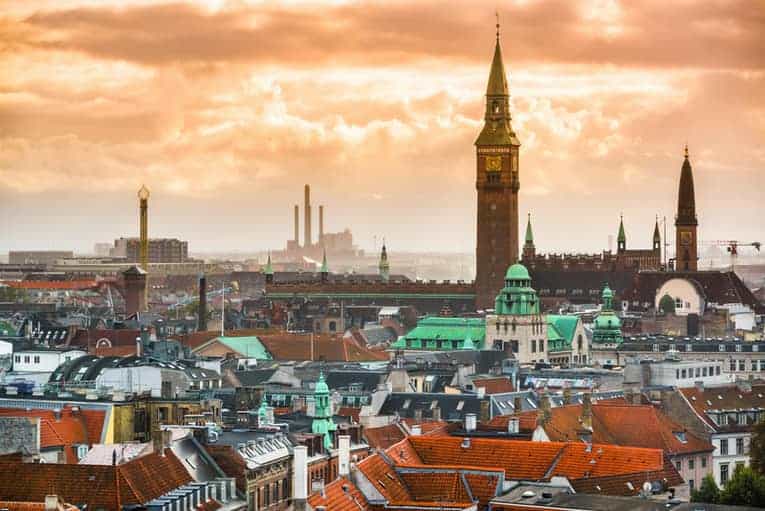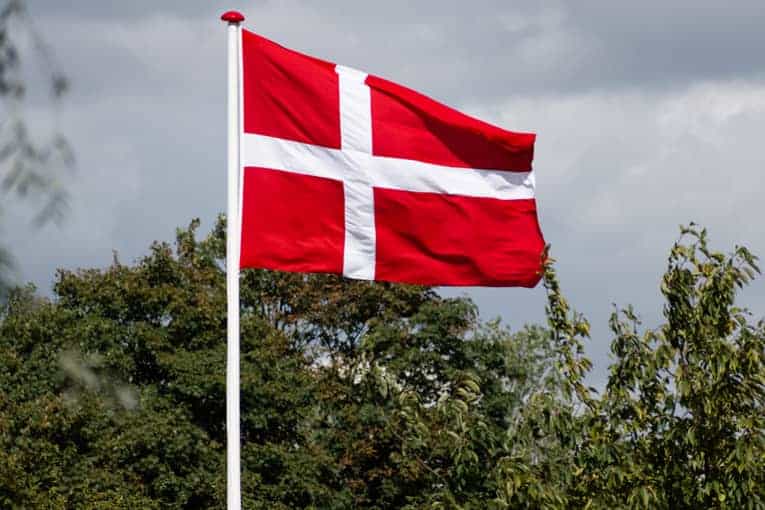The pursuit of happiness is common to all people. People of all nations, no matter their race, religion, or politics, make decisions, plan for the future, and implement change to raise their quality of life.
While what makes people happy is sometimes subjective, there are certain objective aspects, like physical health, that can be measured and compared.
Scandinavian countries like Norway, Denmark, Sweden, Finland, and Iceland, rank among the Top 10 happiest nations in the world, according to multiple indicators.
In recent years, Scandinavia nations have occupied the top three spots on the list when compared to over 150 countries.
The World Happiness Report surveys over 150 countries and then rank them according to their citizens’ perceived level of happiness.
The report synthesizes strategic data points gathered together from industry experts, polls, such as Gallup, and academic studies.
Some Scandinavians attribute their wellness to the practice of hygge, but what is it? See Hygge: What Is It? Why Is It Popular? to learn more.

Happiness around the world
According to the survey, the purpose of the report is to assess wellness:
Its central purpose remains as it was for the first Report, to review the science of measuring and understanding subjective well-being, and to use survey measures of life satisfaction to track the quality of lives as they are being lived in more than 150 countries. [1]
People are often interested in where their country ranks and why. They are also curious how their home country compares to others.
Why are some countries ranked higher? Why are other countries ranked lower? What can be learned from organizing the data in such a list?
People also want to know about what criteria are being compiled to arrange the rankings. What if certain criteria are valued more or less in a particular culture? What criteria don’t include data points that are valued in my culture?
These questions make the World Happiness Report fascinating.
What is Scandinavia doing right? One of the central curiosities that emerge from the reporting year after year is why Scandinavian countries fare so well.
Almost every country in the world is looking up at Norway, Denmark, Sweden, Finland, and Iceland in the list. Why?
Is Democratic Socialism a reason why people in Scandinavia are so happy? See Democratic Socialism: What’s the Controversy? to learn more.

Key indicators of happiness
The study states, “Clearly, when it comes to the level of average life evaluations, the Nordic states are doing something right.” [2]
There are six key happiness indicators that make up the survey results, and two other areas are also tracked.
Scandinavian countries rank comparatively well in almost every one of these metrics when compared to other nations around the world. Six predictors of perceived happiness:
1. Finances – Does money lead to happiness? Does the lack of it ensure misery?
The report suggests that while money may not matter most, financial stability and concerns play are role in how people the quality of their evaluate their lives and their level of happiness.
Gross Domestic Product (GDP) per capita reveals a country’s economic output per person. It’s calculated by dividing the GDP of a country by its population.
The “take away” from this data can inform people about issues, such as the living conditions in a particular country.
Scandinavian countries rank very high when it comes to GDP per capita, as shown on the charts below.
2. Health – Do physical and mental wellness play a role in being happy? Every country in the world desires its citizens to be healthy, not sick.
Wellness is always promoted while disease and illness are fought with medicine, technology, and other healthcare services.
Life expectancy at birth reflects the average number of years that a newborn could expect to live in relation to age-specific mortality rates.
This metric implies the strength and stability of healthcare in a particular country.
While the healthcare system in Scandinavian countries is controversial to some because of how it’s funded (i.e., with high taxes), the care it provides people ranks among the best in the world.
3. Relationships – Do loved ones contribute to happiness? Citizens of every country prize their family and friends, suggesting that healthy, human relationships are a human desire.
People all over the world say life is better when surrounded by family and friends. The social support metric seeks an answer to the question,
“If you were in trouble, do you have relatives or friends you can count on to help you whenever you need them, or not?”
4. Liberty – The ability to make choices for oneself is critical to having a high quality of life, according to the report. People want to determine of their own free will where to go, what to do, and who to be with.
Restricting individual liberties results in a lower standard of life worldwide.
The metric that assesses the freedom to make life choices seeks an answer to the question,
“Are you satisfied or dissatisfied with your freedom to choose what you do with your life?”
5. Charity – Concern for neighbors and helping those in need is part of what makes up a happy society, according to the report. Giving to those in need freely and sacrificially, without compulsion, is valued all around the world. The metric that assesses giving to others generously seeks an answer to the question,
“Have you donated money to a charity in the past month?”
6. Corruption – No country in the world collectively values dishonesty and holds it up as a virtue. People don’t want fraud, theft, bribery, and other manifestations of corruption in their economic, judicial, or financial systems.
People all over the world want to live in a trustworthy society. The metric that aims to measure dishonesty in public and private sectors seeks an answer to the question,
“Is corruption widespread throughout the government or not?” and “Is corruption widespread within business or not?
7. Positive experiences – This measurement reveals if people have experienced happiness, laughter, and enjoyment “during a lot of the day yesterday?” [3]
8. Negative experiences – This measurement reveals if people experienced worry, sadness, and anger the previous day. Based on these measurements, all five countries that are traditionally considered part of the Scandinavian region, finished in the top seven in the world when it comes to happiness. The top 10 countries are:
- Finland – Scandinavia
- Denmark – Scandinavia
- Switzerland
- Iceland – Scandinavia
- Norway – Scandinavia
- Netherlands
- Sweden – Scandinavia
- New Zealand
- Austria
- Luxembourg
Scandinavian countries fare so well in the survey, the report devoted an entire chapter to those five nations. In the overview, it states:
Clearly, when it comes to the level of average life evaluations, the Nordic states are doing something right, but Nordic exceptionalism isn’t confined to citizen’s happiness.
No matter whether we look at the state of democracy and political rights, lack of corruption, trust between citizens, felt safety, social cohesion, gender equality, equal distribution of incomes, Human Development Index, or many other global comparisons, one tends to find the Nordic countries in the global top spots. [4]
The flags of Norway, Denmark, Sweden, and other Scandinavian countries have similarities and differences. See Flags of Scandinavia to learn more.
Happiness in Finland
According to the survey, Finland is the happiest country in the world.
Many of the scores for the Top 10 nations are close, yet when collectively aggregated, Finland comes out on top.
It ranks particularly high in areas like GDP per capita, social support, and freedom to make life choices.
| Metric | Score |
|---|---|
| Gross Domestic Product per capita | 10.63 |
| Social support | .954 |
| Life expectancy | 71.9 |
| Freedom of choices | .949 |
| Generosity | -0.05 |
| Corruption | .195 |
When compared to other high-ranking countries, Finland has room to improve, for instance, when it comes to life expectancy.
This shows that while their healthcare system generally receives positive reviews from citizens, it is not perfect.
Nevertheless, Finland’s overall score with regard to its people’s perceived level of happiness is strong.

Happiness in Denmark
Denmark, the only Scandinavian country physically connected to mainland Europe, is the second happiest country in the world.
Like Finland, it ranks high in GDP per capita, social support, and freedom of choice.
In other words, Danes have less concern and are more assured when it comes to financial stability, interpersonal relationships, and individual liberty.
| Metric | Score |
|---|---|
| Gross Domestic Product per capita | 10.77 |
| Social support | .955 |
| Life expectancy | 72.4 |
| Freedom of choices | .951 |
| Generosity | .066 |
| Corruption | .195 |
In comparison to the residents of other highly-ranked nations, Danes live approximately 18 months less than the #4 overall ranked country, Switzerland.
However, they live a little longer than citizens of the #1 ranked country, Finland.

Happiness in Iceland
Iceland is ranked #1 in the world when it comes to social support, according to the survey.
The island nation exhibits strong bonds and a spirit of helpfulness among its residents.
Some speculate if the isolation of the island nation contributes to a unique identity that positively impacts their perceived level of happiness.
Thus, according to the report, people all around the world can learn from the relationships Icelanders have with one another.
| Metric | Score |
|---|---|
| Gross Domestic Product per capita | 10.77 |
| Social support | .974 |
| Life expectancy | 73 |
| Freedom of choices | .948 |
| Generosity | .246 |
| Corruption | .711 |
While Iceland’s GDP per capita is in line with the two nations ranked above it, the residents’ perception of public and private corruption is higher than other countries ranked in the Top 10, according to the report.
Happiness in Norway
Financial strength and stability, in part, characterize the happiness level of many Norwegians.
Only five nations in the world received a score above 11 when it comes to GDP per capita and Norway was one of them.
The others were Luxembourg (11.45), Ireland (11.16), United Arab Emirates (11.1), and Singapore (11.39).
| Metric | Score |
|---|---|
| Gross Domestic Product per capita | 11.08 |
| Social support | .952 |
| Life expectancy | 73.2 |
| Freedom of choices | .955 |
| Generosity | .134 |
| Corruption | .263 |
To climb higher in the rankings, Norway would increase its generosity score and lower its corruption score.
Their measurements in other categories are already among the highest in the world.

Happiness in Sweden
Among the nations in the Top 10, including its Scandinavian neighbors, Sweden ranks low in GDP per capita and social support, in which it comes in last place.
Of course, in comparison to other countries in the world, Sweden’s measurements are among the highest.
| Metric | Score |
|---|---|
| Gross Domestic Product per capita | 10.75 |
| Social support | .926 |
| Life expectancy | 72.6 |
| Freedom of choices | .939 |
| Generosity | .111 |
| Corruption | .25 |
Theories for Scandinavian happiness levels
Because Scandinavian nations dominate the World Happiness Report, analysts have developed theories to explain the survey results.
The report notes that these factors described below are “highly correlated with each other and often also mutually reinforcing.” [5]
Welfare state generosity: Nordic countries give their citizens a high number of social benefits compared to other countries. “Studies suggest that one secret to Nordic happiness is the institutional framework of the Nordic welfare state.” [6]
The social benefits that Scandinavian nations supply their citizens in the areas of healthcare, education, and retirement or pensions is among the highest in the world. The report summarizes:
People tend to be happier in countries where there is easy access to relatively generous welfare benefits, and where the labor market is regulated to avoid employee exploitation. [7]
This reality contributes significantly to Scandinavians’ perceived level of happiness.
Institutional quality: This metric identifies important criteria such as access to institutions, like in a democratic system, lack of corruption, and freedom to political associates.
“The quality of the government and public institutions matter for life satisfaction,” the reports state. “The Nordic countries tend to occupy the top spots in international comparisons of government equality.”
Income inequality: Scandinavian counties are well-known for having low levels of income inequality. Yet, the report states that it is not certain that a lack of income inequality explains their high levels of happiness:
The Nordic countries are also famous for low levels of income inequality, but the evidence is not clear that a lack of income inequality is a potential explanation for high life satisfaction. [8]
It is clear, however, that if income inequality is perceived to be the result of, for example, institutional corruption, their satisfaction score will be lower:
if inequality leads to lower levels of perceived fairness and trust, and high levels of status anxiety and lack of economic and social opportunities, these factors might more directly contribute to a lower life satisfaction in the nation. [9]
Freedom to make life choices: Liberty contributes to perceived levels of happiness. People in Scandinavian countries believe that they have the freedom to make choices.
Studies have shown that such autonomy is rooted in three factors:
- Material possessions, as opposed to scarcity
- Democratic processes, as opposed to political oppression
- Cultural values that champion for free expression
The report summarizes:
Thus the high sense of autonomy and freedom – and the resulting high well-being – that Nordic citizens experience can be attributed to relatively high material prosperity combined with well-functioning democracy and liberal values that prevail in the Nordic countries. [10]
Social cohesion: People who can trust others are happier than those who can’t. The ability to trust others, as well as institutions, reduces anxiety and feelings of isolation.
People are also better able to withstand hard times, such as national emergencies, when trust is strong.

Critical responses to Scandinavian happiness levels
The report also offers responses to commonly raised questions and concerns about the perceived levels of happiness in Scandinavian countries. It addresses four different concerns:
Weather: don’t the gray skies make Scandinavians less happy? Some people generally expect nations that have climates with many sunny days and warm weather to rank high.
Nordic countries are sometimes dark and cold in relation to their countries, especially in the winter.
The report notes that Scandinavians are affected by the weather, just as citizens of any other nation are, but the measurement of it is not enough to change the overall survey results.
Suicides: isn’t mental illness an issue in Scandinavia? In an article titled “Why Nordic Countries Might Not Be As Happy As You Think,” the BBC reported:
A report authored by the Nordic Council of Ministers and the Happiness Research Institute in Copenhagen aims to provide a more nuanced picture of life in the Nordic nations – suggesting their reputations as utopias for happiness are masking significant problems for some parts of the population, especially young people…
It asked people to mark their satisfaction with life out of 10 – with people above a seven categorized as thriving, fives and sixes as struggling and anyone scoring below a four deemed to be suffering.
It found that in total 12.3% of people living in the Nordic region said they were struggling or suffering, with 13.5% of young people ranking themselves as such. [11]
In the second half of the 19th century, Nordic countries had some of the highest suicide rates in the world.
At the beginning of the 20th century, that measurement began to change in a positive way.
The report states that today, Scandinavian countries experience suicide at approximately the same rate as their European neighbors.
The report states that the paradox between high levels of happiness and high suicide rates “seem to be based on outdated information.” [12]
However, what the BBC and other critics are pointing out concerns mental health in Scandinavian countries, not just the number of suicides.
Population: isn’t easier to make smaller groups happy? This critical response is based on the smaller populations of Scandinavian countries.
It can be summarized by saying, it’s easier to make small groups of people happy.
Large countries have more diverse populations and some have minority groups that may perceive happiness differently than the majority.
The report replies by pointing out that 19% of Sweden’s population was born outside the country.
Furthermore, the 10 happiest countries in the world on the list have “foreign born populations shares averaging 17.2 %, about twice as much as the world average.” [13]
Comparison countries: examples
| Country/Rank | GDP | Soc. | Life | Free. | Gen. | Corr. |
|---|---|---|---|---|---|---|
| Canada #11 | 10.69 | 9.27 | 73.6 | 9.33 | 1.24 | 3.9 |
| U.K. #13 | 10.6 | .936 | 72.3 | .834 | .263 | .435 |
| Germany #17 | 10.73 | 8.98 | 72.2 | 8.67 | 8.01 | 4.56 |
| U.S. #18 | 10.92 | .914 | 68.29 | .842 | .149 | .699 |
| Mexico #24 | 9.79 | 8.38 | 68.2 | 8.58 | -1.75 | 8.06 |
| Brazil #32 | 9.56 | 8.96 | 66.4 | 7.99 | -1.01 | 7.7 |
| Russia #73 | 10.12 | .903 | 64.1 | .729 | -.151 | .864 |
| China #94 | 9.68 | .798 | 62.9 | .898 | -.181 | .75 |
| Nigeria #115 | 8.57 | 7.37 | 49.8 | 7.59 | 3.37 | 8.6 |
| India #144 | 8.84 | 5.92 | 60.2 | 8.81 | 5.75 | 7.7 |
The bottom five countries on the list:
- Central African Republic: #149
- Rwanda: #150
- Zimbabwe: #151
- South Sudan: #152
- Afghanistan: #153
References:
[1] Source
[2] Source
[3] Source
[4] Source
[5] Source
[6] Source
[7] ibid.
[8] ibid.
[9] ibid.
[10] ibid. cf. Inglehart, R., Foa, R., Peterson, C., & Welzel, C. (2008). Development, freedom, and rising happiness: A global perspective (1981–2007). Perspectives on Psychological Science, 3(4), 264–285.
[11] Source
[12] Source
[13] ibid
